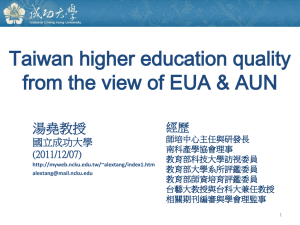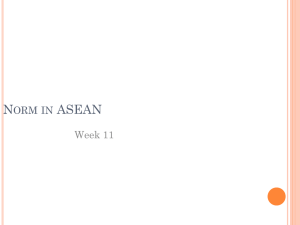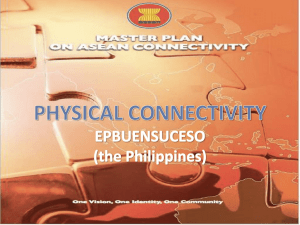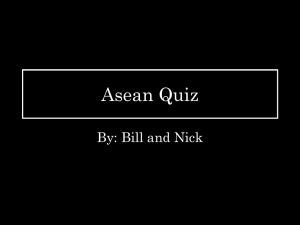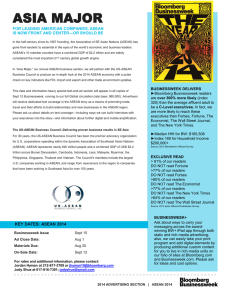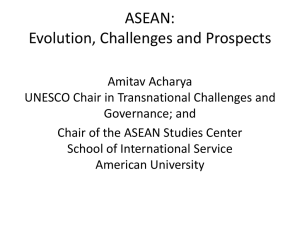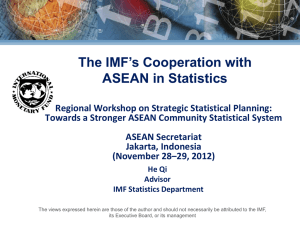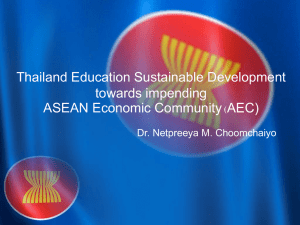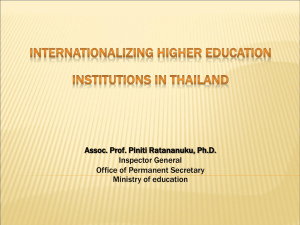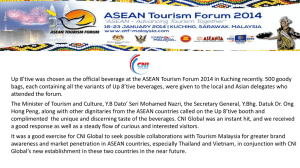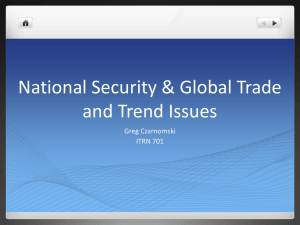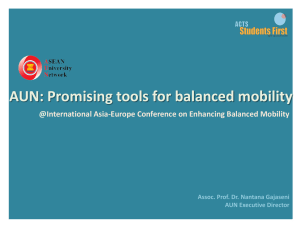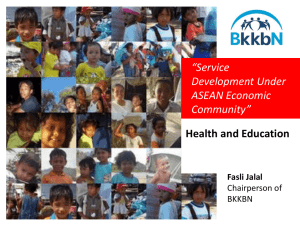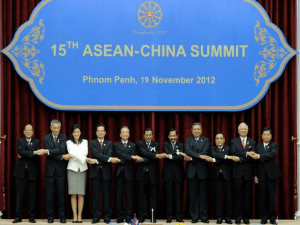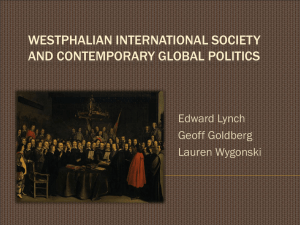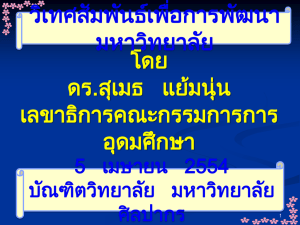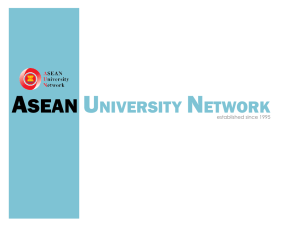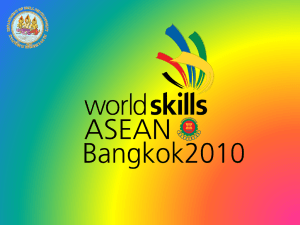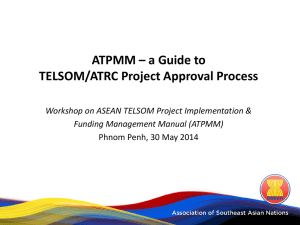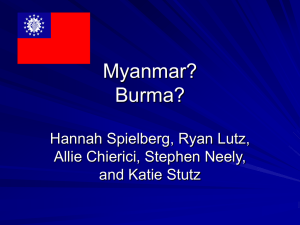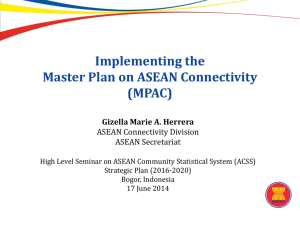here - transcend
advertisement
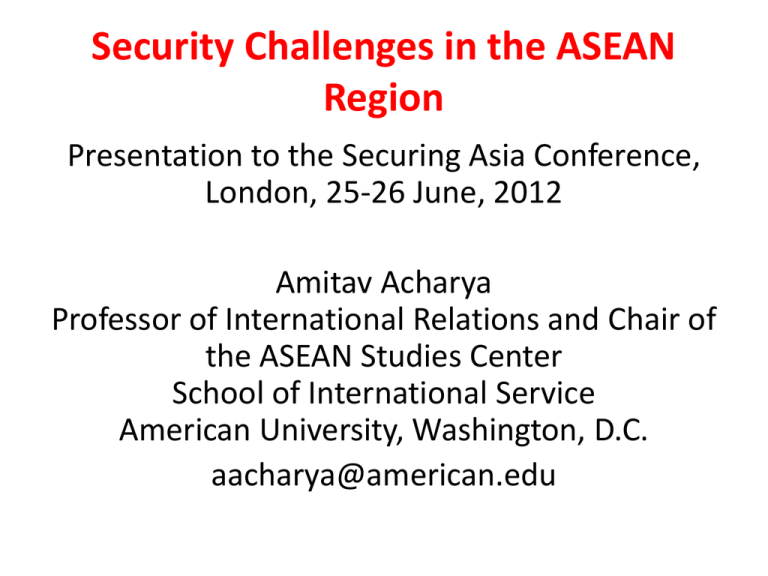
Security Challenges in the ASEAN Region Presentation to the Securing Asia Conference, London, 25-26 June, 2012 Amitav Acharya Professor of International Relations and Chair of the ASEAN Studies Center School of International Service American University, Washington, D.C. aacharya@american.edu ASEAN Map ASEAN in Asia ASEAN’s Global and Regional Importance • Combined population of 600 million • Combined GDP of US$1.8 trillion, slightly larger than India’s • Critical Sealanes: Malacca, Sunda, Lombok Straits • Indonesia: World’s largest Muslim nation, 3rd largest country in overall population • An Economic Community by 2015 • Immediate neighbor of India and China- hence a theatre for their conflict and cooperation What is ASEAN? • A multipurpose regional organization promoting economic integration and cooperative security • Established in 1967 (Indonesia, Malaysia, Philippines, Singapore, and Thailand) with the goal “to promote regional peace and stability through abiding respect for justice and the rule of law in the relationship among countries of the region and adherence to the principles of the United Nations Charter” • Not a military alliance, but through its Treaty of Amity and Cooperation, 1976, sets up principles of conduct, including non-interference in internal affairs, pacific settlement of disputes, now signed by all major world powers Characterstics of Membership • Diverse cultures: Muslim, Buddhist, Christian, Confucian • Divergent colonial history: – – – – – British (Malaysia, Singapore, Brunei, Myanmar) Dutch (Indonesia) French (Vietnam, Cambodia, Laos) Spanish/American (Philippines) Portugese (East Timor) • Different political systems: – Military Myanmar), communist (Vietnam, Laos), softauthoritarian (Malaysia and Singapore), stable democracy (Indonesia), unstable democracy (Thailand and Philippines) – parliamentary democracy, presidential democracy ‘ASEAN Way’ Not the European Union • Informality of interactions • Non-legalistic cooperation • Consensus-based approach • Inclusivity in membership and external relations ASEAN’s Security Challenges • Old and new insurgencies - southern Philippines, southern Thailand, Myanmar, West Papua • Political uncertainty and instability - Myanmar, Thailand • Inter-state disputes and tensions - Thai-Cambodia border, South China Sea conflict • Power shift and great power rivalry - China/US, ChinaIndia, China-Japan • Transnational/Non-traditional security threats – terrorism, transboundary haze, maritime piracy, pandemics, transnational crime, drug trafficking, people smuggling, natural disasters) Defence and Security Threat Overvew • Shift from counter-insurgency to conventional warfare Post-Cold War Developments • Expansion of membership- Vietnam (1993), Laos and Myanmar (1997), and Cambodia (1999) • Launching of ASEAN Regional Forum (1994) – a multilateral security organization including the US, China, India, Russia, and EU. Agenda includes confidence-building, preventive diplomacy and conflict resolution, but political differences and sovereignty concerns has kept it from undertaking the latter two functions. Lately, it has shifted focus towards transnational security issues, especially disaster management and terrorist financing. • Declaration on the Conduct of Parties in the South China Sea (2002). • Bali Concord II (2003): ASEAN Political Security Community (APSC), to be realized by 2015. A broad framework that covers conflict resolution; counter-terrorism, anti-piracy measures, intelligencesharing, and disaster management. Post-Cold War Developments- contd. • East Asia Summit (2005): Expanded to 18 members, including the 10 ASEAN members, China, Japan, South Korea, US, Russia, India, Australia and New Zealand. Agenda includes energy, environment, Avian Flu, poverty eradication, natural disaster mitigation, and finance. Attracted attention for its discussion of the South China Sea conflict, despite China’s effort to keep this issue out of the EAS’ agenda. • ASEAN Defence Ministers’ Meeting (2006) and ADMM Plus (2010) – A forum for exchange of views on regional and international security issues and is primarily a confidence-building exercise. Longterm goals include developing cooperation for humanitarian assistance and disaster relief, maritime security, military medicine, counter-terrorism and peacekeeping operations (PKO). Some Achievements • No war among members since founding • Ending the Cambodia conflict and reconciliation with Vietnam • Engaging all the major powers of the world – China, US, Japan, India, Russia, EU) to prevent any single power from dominating the region and inducing mutual restraint among them Gaps, Limitations, Challenges • Recent Intra-ASEAN conflicts: Thailand-Cambodia. No significant role in dispute-settlement, despite existence of dispute settlement mechanisms, relying instead in informal peer pressure and good offices. • No peacekeeping force and limited humanitarian assistance missions (e.g. Cyclone Nargis in Myanmar in 2008). • Military modernization and arms race • The ARF is yet to move beyond confidence-building to preventive diplomacy and conflict resolution. • Escalation of the South China Sea dispute, and the difficulty and delays in negotiating a binding code of conduct agreement on a binding Code of Conduct. South China Sea Claims Gaps, Limitations-contd. • ASEAN security and defence cooperation mainly geared to dialogue and building confidence. Operational activities have been undertaken primarily on a bilateral or trilateral basis, such as the anti-piracy patrols in the Malacca Straits, or multilaterally in areas such as disaster management simulations. • Mixed progress in dealing with terrorism, people smuggling, and pollution Reasons for Mixed Record • Differing threat perceptions (especially over China) • Mutual distrust • Territorial disputes • Sovereignty and the non-interference mindset • Weak capacity for peacekeeping and peacebuilding activities Challenges for the Future • Rise of China and India, a multipolar world • Increasing burden: scope of issues, and membership, and partnerships • Sovereignty and non-Interference in an age of globalization and transnational challenges Two questions for the future - Can ASEAN’s centrality in Asian regional architecture be assured for next 20 years? -ASEAN 2030: “Wise counsel of Asia or marginalized relic of the past” Further Reading on ASEAN Michael Leifer, The ASEAN Regional Forum (London: IISS, 1996) Amitav Acharya, Constructing a Security Community in Southeast Asia: ASEAN and the Problem of Regional Order (London and New York: Routledge, 2001, 2009) Jurgen Haacke, ASEAN's diplomatic and security culture: Origins, development and prospects (Routledge, 2003) Alice D. Ba, (Re)Negotiating East and Southeast Asia: Region, Regionalism, and the Association of Southeast Asian Nations (Stanford 2009) Amitav Acharya, The Making of Southeast Asia: International Relations of a Region (Cornell Studies in Political Economy, 2012)

